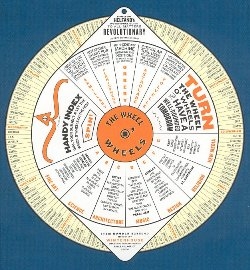February 25 - April 24, 2004
Volvelles: the Magnificent Art of Circular Charting
Curated by Jessica Helfand & William Drenttel
 As inventive as they are instructive, information wheels, or volvelles, have been used since the 14th century to measure, record, predict, and calculate everything from time and space to military history and pharmaceutical compounds. From the medieval Latin verb volvere, to turn, a volvelle is a calculation device consisting of concentric moveable circles, dials or index arms surrounded by other circles, serving to mimic or calculate the positions of the sun, moon, stars, planets and tides, as well as for calculating calendars, decoding cyphers, anticipating planting times, calibrating speed, measuring distance, and so on.
As inventive as they are instructive, information wheels, or volvelles, have been used since the 14th century to measure, record, predict, and calculate everything from time and space to military history and pharmaceutical compounds. From the medieval Latin verb volvere, to turn, a volvelle is a calculation device consisting of concentric moveable circles, dials or index arms surrounded by other circles, serving to mimic or calculate the positions of the sun, moon, stars, planets and tides, as well as for calculating calendars, decoding cyphers, anticipating planting times, calibrating speed, measuring distance, and so on.
Though static in a physical sense, volvelles are also implicitly dynamic, offering everything from inventory control to color calibration, mileage metering to verb conjugation. They anticipate breeding cycles and calculate radiation exposure; measure chocolate consumption and quantify bridge tips; they chart bird calls, convert metrics and calculate taxes. There are fortune telling wheels and semaphore charting wheels; emergency first-aid wheels and electronic fix-it wheels; playful wheels that test phonetics and prophylactic wheels that prevent pregnancy. Yet despite their wide range of content, volvelles share a unique approach to information design, celebrating the multiple graphic opportunities inherent in successive rotating dials.
From the golden age of celestial cartography to more contemporary applications of both language and form, Volvelles demonstrates both the astonishing range and remarkable utility of these ingenious "interactive" tools. On view at the Grolier Club from February 25 - April 24, 2004, the exhibition features more than 120 works, including a range of historical as well as contemporary examples from private and institutional collections, many never before exhibited.
Highlights of the exhibition will include:
- Seminal works of celestial cartography, including Johannes Hevelius's Selenographia (1647), one of the most widely read books of the seventeenth century that includes a lunar atlas with topographical volvelles of the moon's surface, and Peter Apianus' Astronomicum Caesareum (1540), printed by hand with more than 20 astronomical volvelles designed to map planetary positions, predict eclipses and to calculate times of crisis in illness.
- A selection of almanacs and calendars, including Johannes Mueller's Kalendarium (1476); the Jewish calendar Sefer Evronot, (1627); and Antonio Carrarino's Opera Astrologica, (1581), a perpetual calendar of planetary hours published one year before the introduction of the Gregorian Calendar.
- Works on cryptography, including Johanne Trithemius' Polygraphie, (1561), the French translation by Gabriel de Collange of the original treatise on substitution and transposition ciphers.
- Examples of concrete poetry, including a limited edition "perpetual" poem, La Rose et le Chien (1958), by Tristan Tzara and Pablo Picasso.
The fully illustrated 160-page color catalogue, published by Princeton University Press and Winterhouse Editions in 2002, will be for sale at the Grolier Club at a cost of $25.00. In 2003, it won the award for Best Design from the Connecticut Center for the Book.
LOCATION AND TIMES: Volvelles: The Magnificent Art of Circular Charting will be on view at the Grolier Club from February 25 - April 24, 2004. Hours: Monday-Saturday 10 AM - 5 PM. Open to the public free of charge.